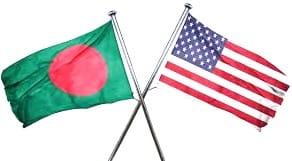Bangladesh finally managed to get the US imposed retaliatory tariffs by 15 percentage points to 20 percent after holding a series of trade talks with Washington.
The decision was made official through an executive order signed by President Donald Trump on Thursday. The new tariff rate takes effect Friday, reports Reuters.
This move comes after three days of intense discussions between Bangladeshi trade officials and representatives from the Office of the U.S. Trade Representative (USTR).
The tariff cut is expected to ease pressure on Bangladeshi exporters and enhance the country’s competitiveness in the American market.
In addition to Bangladesh, the executive order lists updated tariff rates for several other countries: 19% for Pakistan and Indonesia, 15% for Afghanistan, 25% for India, 10% for Brazil, 19% for Malaysia and the Philippines, 40% for Myanmar, and 20% for both Sri Lanka and Vietnam.
Earlier on April 2, citing concerns over trade deficits, President Trump imposed steep retaliatory tariffs on numerous countries, including a 37% tariff on Bangladeshi goods. However, on April 9, the U.S. suspended the tariffs for three months to allow for negotiations. That window closed on July 9.
Just ahead of the deadline, Trump informed Bangladesh’s interim government head, Professor Muhammad Yunus, via letter that the tariff would be reduced to 35%.
However, the rate was not immediately implemented. Washington extended the negotiation deadline to July 31, aiming to finalize trade agreements with affected countries.
For Bangladesh, this means that exports to the U.S. will now be subject to a combined tariff structure: a 15% base duty plus the new 20% retaliatory tariff, totaling 35%.
In contrast, India was subjected to a 25% tariff after failing to finalise a comprehensive agreement with Washington.
“We negotiated carefully to ensure that our commitments aligned with our national interests and capacity,” said Dr. Khalilur Rahman, Bangladesh’s National Security Adviser and lead negotiator. “Protecting our apparel industry was a top priority, but we also focused our purchase commitments on U.S. agricultural products. This supports our food security goals and fosters goodwill with U.S. farming states.”
Dr. Rahman added, “Today, we successfully avoided a potential 35% reciprocal tariff. That’s good news for our apparel sector and the millions who depend on it. We’ve also preserved our global competitiveness and opened up new opportunities to access the world’s largest consumer market.”
The new agreements go beyond tariff adjustments. They include commitments on domestic policy reforms, procurement of U.S. goods, and addressing broader economic and national security concerns. Countries were required to make explicit pledges to purchase U.S. goods to help narrow trade deficits, while also addressing non-tariff barriers and security-related issues.
President Trump’s executive order stated that each country’s final tariff rate would reflect the extent of its commitments across these areas.
Congratulating the negotiating team, the Chief Adviser of Bangladesh’s interim government hailed the deal as a landmark diplomatic victory.
“By reducing the tariff to 20%—17 points lower than initially anticipated—our negotiators have demonstrated exceptional strategic acumen and an unwavering commitment to protecting Bangladesh’s economic interests,” the Chief Adviser said.
“They have worked tirelessly since February, navigating a complex process involving tariff, non-tariff, and national security matters. The agreement they secured preserves our comparative advantage, enhances our access to the U.S. market, and safeguards our core national interests.”
“This achievement highlights Bangladesh’s growing stature on the global stage and paves the way for increased opportunities, accelerated growth, and lasting prosperity,” he added. “Today’s success is a powerful testament to our national resilience and bold economic vision for the future.”

